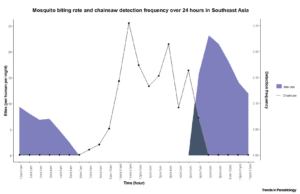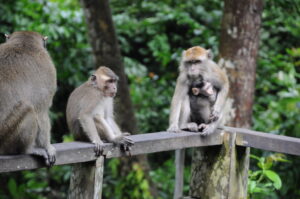
“If a tree falls in a forest and no one is around to hear it, does it make a sound?” You might be familiar with this philosophical thought experiment – and bioacoustics might just be the thing that lets us listen not only for the trees, but for other things happening in the forest.
A recent review by Johnson and colleagues published in Trends in Parasitology describes how bioacoustics can provide information beneficial to disease surveillance. Acoustics has been used to research disease vectors mainly in lab settings, for example through the studies of mating behaviours of sandflies or mosquitoes. Other studies have shown how mobile devices could be used to collect data on mosquito sounds to provide an identification of species as well as their distribution. Now, bioacoustics is proposed to answer questions on the presence, distribution and movements of vector and host species in the wild.
Passive acoustic monitoring (PAM) is an approach that deploys sound recorders in the wild to monitor species in terrestrial or aquatic ecology and conservation, providing valuable information on biodiversity and ecosystem health. Interesting examples of this application is the surveillance of white-nose syndrome in bats allowing researchers to look at behavioural changes and disease progression in these populations, and of chytridiomycosis in frogs to listen for changes in their call patterns.
What would this look like for zoonotic diseases?
Bioacoustics could help monitor epidemiological variables, especially for pathogens with sylvatic reservoirs; for instance, looking at wildlife interactions with livestock or human settlements. Acoustic data would be most useful when used to complement that of other studies, such as mark-recapture and GPS tagging. Moreover, while other approaches like drones and LiDAR have been successful in mapping mosquito breeding sites and monitor livestock populations, these are better suited to open landscapes, and bioacoustics could provide information in more closed up/forested areas.
Another use for these types of studies, Johnson and colleagues describe, is in the monitoring of human movement or activities, and how pathogens are spread at the human-wildlife-ecosystem interface. For example, the comparison of human chainsaw activities vs. mosquito biting rates in Indonesia suggested a high-risk time for malaria transmission.

The review also lists some of the technology available to use in these types of studies, including low-cost sensors or autonomous recording units (ARUs) and open-source acoustic sensors, where parameters can be adjusted depending on the questions being asked by the researchers.
Analysing the data
Disentangling specific sounds recorded during these studies can take advantage of machine learning to identify interesting signals, reducing the complexity of data analysis. However, the authors caution that for many species there is still very little or no data to train the algorithms, a gap that needs to be filled to support future larger scale studies.
Another option is to look at the bigger picture, something called “soundscape analyses”. It is based on comparing the richness of sounds in space and time to provide information on how changes in biodiversity and habitat disturbances are influencing disease transmission. A third scenario uses “acoustic indices”, which convert certain sound parameters and simplifies them into numerical values, allowing you to quantify changes in the environment; the review warns, however, that the evidence is not strong for this method.
A case study: monitoring zoonotic malaria in Sabah
Authors from the review are part of the SENSOR project, which is looking at modelling the spillover of zoonotic and vector-borne diseases related to land-management practices. As part of its methods, SENSOR will use acoustic surveying to monitor the long-tailed macaque, a reservoir of zoonotic malaria in Sabah (Malaysia). Setting up the ARUs requires a good knowledge of the area to make sure most disturbances interfering with data collection can be mitigated. Pilot studies have shown the recording units can attract the attention of monkeys, birds, and other animals, and so once programmed they are set up with their battery packs in waterproof casings inside a protective wire cage. This approach will help researchers understand how the epidemiology of Plasmodium knowlesi in Sabah is influenced by the movement of the macaques, which is in turn affected by factors like deforestation.

The pros and cons
Acoustic monitoring is a non-invasive method that can support disease surveillance in some ecosystems, providing complementary information to what other more labour-intensive field methods are currently gathering. The authors explain that this approach is not without its limitations: reservoir species that don’t produce audible sounds, resources and personnel for initial deployment and maintenance, as well as data storage or processing are some of the challenges it presents.
On the other hand, satellite connections, cloud-computing, solar powered equipment, and developments in machine learning will enhance the possibilities of what passive acoustic monitoring can accomplish. It is a different approach that can offer new insights into the soundscapes of disease epidemiology.

Comments